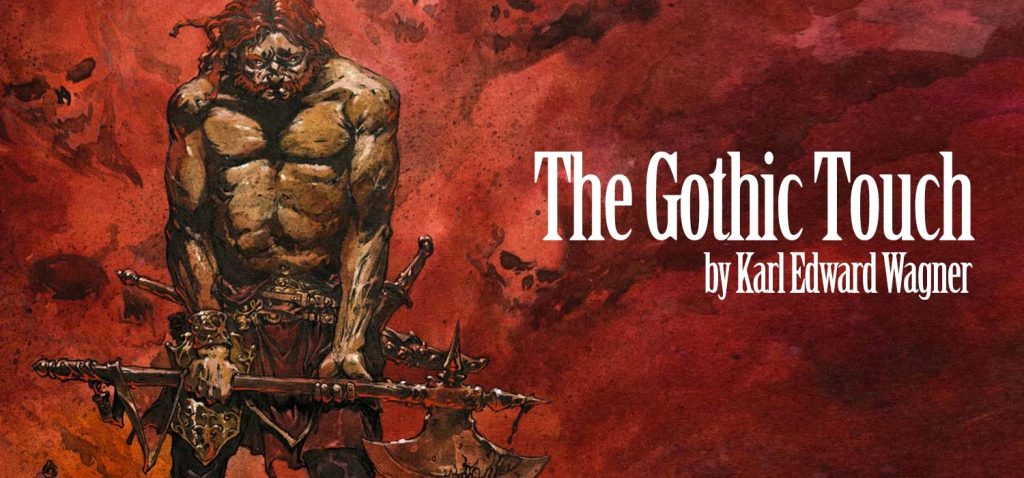Kane Meets Elric: Karl Edward Wagner’s “The Gothic Touch”
by Fletcher Vredenburgh
King Kong vs Godzilla, Green Gargantua vs Brown Gargantua, Superman vs Batman: these are the sort of epic contests I envisaged when I realized Karl Edward Wagner had penned a story bringing his thoroughly detestable and awesome Kane together with Michael Moorcock’s more effete cursed albino, Elric of Melniboné. I mean, these are two of the most iconic characters from swords-and-sorcery’s renaissance, but I didn’t get that when I read “The Gothic Touch,” one of Wagner’s last stories, published the month after his death in Michael Moorcock’s Elric: Tales of the White Wolf (1994). Instead, it is a terrific science fantasy/horror story replete with mutant cannibals, aliens, and a freaking atom bomb, made just a little bit melancholy because it is the last tale of Kane.
The Gothic Touch is a fitting conclusion to Wagner’s tales of his immortal wanderer, cursed by the mad god who created mankind. Wagner had said Kane was inspired in part by Charles Maturin’s Gothic protagonist, Melmoth the Wanderer. Melmoth sold his soul to the Devil for 150 more years of life and, in order to escape damnation, must find a willing volunteer as a replacement. In addition, the Kane stories, especially the short stories, are primarily horror stories (unsurprising, considering Wagner was one of the greatest horror editors as well as a fine writer of the stuff). In this final story, Wagner, with great verve, leans all the way into many Gothic motifs. Good sword-and-sorcery should be dark and spooky. Wagner knew how to take it magnificently over the top and beyond.
The story begins with Elric and his companion Moonglum seeking refuge in a reputedly haunted castle, perhaps the most elementally Gothic trope of all. They are being chased by one Duke Breidnor and his men. Finding a fire in the abandoned keep’s fireplace and a table set for dinner, Moonglum expresses concern about the rumored haunting, to which Elric responds: “All ruined castles are haunted . . . At least to the popular mind.” The castle, though, is haunted indeed, as they will soon learn.
Their host is, of course, Kane. He introduces himself coming in from the stormy night wielding a bloodied sword in one hand and Breidnor’s severed head in the other. Elric demands at once to know who the gigantic, red-haired stranger is:
“I’m Kane, and I’m not from around here.”
“Where are your men?”
“I’m alone.”
“How did you manage to kill Duke Breidnor and his soldiers if you were alone?”
“I kill things. That’s what I was created to do. I’m rather good at it.”
“Are you from Arioch?”
“Only a nodding acquaintance.”
Kane has traveled to Elric’s plane in search of something hidden in the bowels of the castle and he needs Elric and his cursed sword, Stormbringer, to kill its demonic guardian. In exchange, he offers the albino prince and his friend a great wealth of gems. Not entirely trusting of Kane, Elric and Moonglum agree to his bargain.
As the trio venture further and deeper into the lower reaches of the castle things become increasingly dangerous – and strange. Ravening monsters are nothing new to Elric, but there is a mystery that eludes his understanding. At the bottom of the cavern below the castle he realizes things aren’t what they seem.
It wasn’t a cavern.
Elric touched his hand to one wall. Not stone. Torn metal. Cold. He pounded the hilt of Stormbringer against its surface. It pealed like a sunken bell. What he first assumed where stalactites and stalagmites were wrenched metal girders. Elric touched them, trying to imagine who had created this broken palace.
“Primarily that’s a titanium and iridium alloy,” Kane said, watching Elric closely. “I’m not certain what else. Likely osmiumas well, but that’s just a guess from the fact the ship is relatively intact. As you will have observed it hit rather hard.”
That’s all I’ll tell about the “The Gothic Touch,” except to say it does feature a mushroom cloud in the end. The three Kane novels, Darkness Weaves (1970), Bloodstone (1975), and Dark Crusade (1976) are good but flawed. It was as a short story writer that Wagner shone as one of the true greats of sword-and-sorcery. He could create a setting, spin up a thick, unsettling atmosphere, and stage bloody action scenes like too few others in only a handful of pages. If you don’t believe me, grab yourself a copy of his two Kane story collections, Death Angel’s Shadow and Night Winds, and enjoy. They are even more successful as horror collections than his actual horror collections.
Kane, more than any other, is my favorite sword-and-sorcery character and I’m not sure what it says about me. Kane is often called an anti-hero, something that annoyed Wagner. I get it, because Kane is a straight-up villain. There are few stories where he saves the day, but it’s usually only because he’s saving his own life. More often than not he’s the evil force at the heart of whatever supernatural madness is going on. Wagner knew how to make Kane, if not sympathetic, than at least someone you still wanted to see win the day.
To find a copy of “The Gothic Touch,” you have to get Tales of the White Wolf. You could get Night Shade’s collection, Midnight Sun, but that goes for hundreds of dollars. Fortunately, Tales of the White Wolf is readily available. That’s a book that contains a lot of other good stories, but I’d hold off on “The Gothic Touch” until you’ve treated yourself to Death Angel’s Shadow or Night Winds first.






